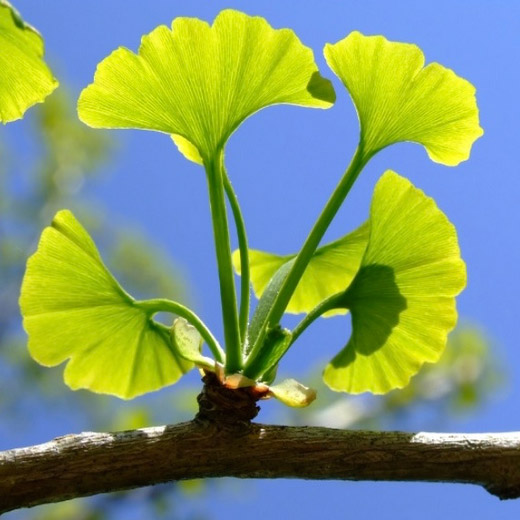
In exquisite billows,
the foliage cascades
from its shrouded source in the sky;
green abundance veils the top-
dwelling place of the lone crane.
Like a dancing phoenix,
its trunk soars to the clouds,
like a coiled dragon perching on a cliff
these images reveal its hidden forces.
(Li Shanji, 19th C) (1)
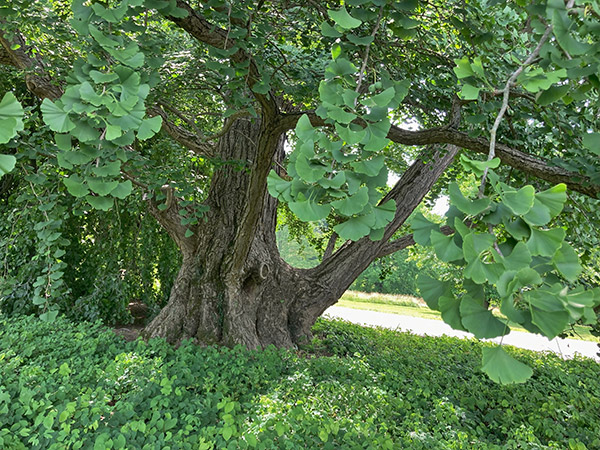
Perhaps the poem and photo are enough of an “ahhhhhh” for you.
AND….I invite you to read on, to look on, to sense on, to feel on, to explore a magic deeper still, with Ginkgo.Ginkgo has been living on the planet, all across the globe, for around 270 million years.
270 million years.
Fossils found of Ginkgo
Found in the fossil records on seemingly all continents (yes, even Antarctica), the Ginkgo of today is the sole surviving species of an ancient group of trees dating back to the time of the dinosaurs.For comparison sake, 55 million year old Oak pollen has been found in the fossil record in Austria; 60 million year old Maple and 140 million years ago for Pine; we homo sapiens (curious title) only 300,000 years. Ginkgo biloba is old than Conifer, and about the same age as the Cycad (the ancient palm-tree-looking cone-bearing plant), and significantly older than any Tree we are familiar with in our daily life.
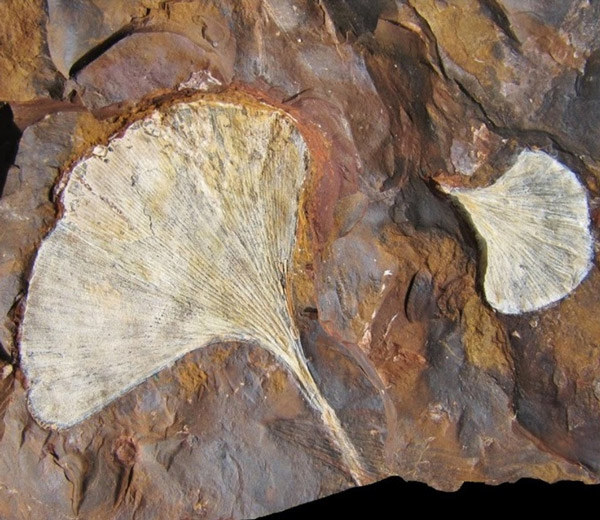
During its long tenure on the planet, Ginkgo inhabited a very different world from the one we live in today — for most of its long life, a world without humans, and with plants and animals long since extinct. As the planet changed over the past 200+ million years, Ginkgo has proved incredibly resilient. Seemingly oblivious to the traumatic events that ended the dinosaurs, Gingko survived and thrived in the the northern continents, flourishing during the planetary warm-up 50 million years ago. But Earth grew cooler again, and around the time our ancestors diverged from other living apes, Ginkgo apparently began to suffer a decline. It barely survived the great Ice Age when our own species was born. By the time the last great southward push of the ice had retreated, there were only a few protected valleys scattered around eastern and south-central China where Ginkgo could be found. (2) Read on further down the page to hear about Ginkgo’s resurgence, in partnership with our species.If you know any botany at all, you may know there are 5 different groups of seed bearing plants; 1 of those 5 is Ginkgo Biloba. In the other 4 groups there are over 350,000 species, but in Ginkgo only 1:
Ginkgo is the only member in its genus,
the only genus in its family
the only family in its order
and the only order in its subclass
Once widespread with many different types, today Ginkgo is often called a Living Fossil. Why? Perhaps it is because Ginkgo is the only surviving specimen of a stage of plant evolution that was annihilated during the last ice age.
Individual Ginkgo trees compete for the title of oldest living specimens of life on earth. Surveys done in China have revealed that there are some ginkgo trees that are over 3,000 years old, with a total of about 180 trees exceeding 500 years of age (2). The largest grove of old ginkgos is in the Tian Mu Shan (Heaven’s Eyes Mountain) Nature Reserve in Jiangsu Province.
Here is a short video link (46 seconds long) to a Ginkgo said to be 6,200 years old in Shanxi Province, in the north part of China. Do take a look!
http://www.ecns.cn/video/2023-06-13/detail-ihcqhipa9369870.shtml
Among its unique features is the fact that the Ginkgo blooms only at night and sheds its blossoms immediately, “as if celebrating the wonder of life in secret” (3). Gingko is also known for its synchronous leaf drop — a huge proportion of the leaves come down in one night, leaving a carpet of yellow surrounding the tree.
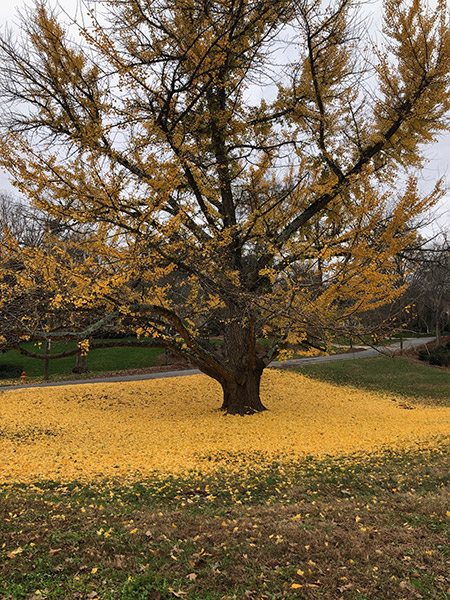
Back in the flow of time and Ginkgos’ magic deeper still: it is possible that human dominance on the planet could’ve spelled the end for the Ginkgo, but unlike many other trees, Ginkgo has flourished in relationship to humans. The nuts are a delicacy and are used for oil and in medicine. The Tree itself took on symbolic meaning in Buddhism, Daoism and Confucianism, and then Shintoism. In the 1700s, trading patterns between Europe and Japan brought Ginkgo to Europe, the Low Countries and Britain. In just a few hundred years, Ginkgo had returned to many of those places from which it had apparently been extinguished millions of years before. (4)
Planted near temples, Ginkgo is considered a reference to the sacred concept of Yin and Yang, the duality of harmonic and opposing forces: Yin as the feminine essence of earth and yang as the masculine essence of sun. Ginkgo trees are also sexed as male or female. Male trees produce pollen, while females produce an odorous fruit containing the desired and edible seed called a Ginkgo nut.
Daoist shamans used to engrave their magical spells on old Ginkgo trees to aid communication with the spirit world. Many Daoist temple courtyards feature ancient Gingko trees that are thousands of years old, and some trees predate the temples and mark the location of earlier worship sites.
Confucius is said to have taught his disciples under a Ginkgo tree. Around the same time, a Chinese relief mural called the Seven Worthies of the Bamboo Grove and Rong Qigi was created on the walls of a royal tomb.This mural has clear illustrations of ginkgo trees in the grove (see the mural below). The seven sages pictured were said to be a scholarly clan who came together during a period of intense political instability in China, and they represented a movement towards freedom and peace.
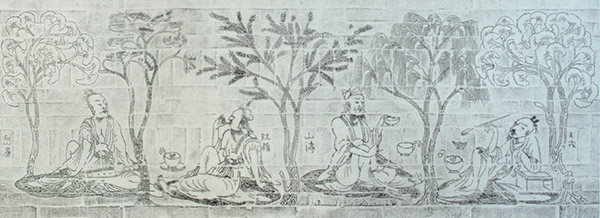
So Ginkgos have been planted near temples, shrines and castles, for veneration yes, and for beauty yes, but also for more earthly protection: Ginkgo is fire resistant. During the great fire after the earthquake in Tokyo in 1923, many Ginkgo trees survived while other trees died. A temple was saved because of the many Ginkgos that surrounded it. There are Ginkgo trees in Hiroshima that survived the atomic bomb blast, because their roots went so deep as to be protected from the incinerating heat. A year after the blast, close to ground zero, a tiny green shoot emerged where a large tree used to live. (If you are in want of an example of rooted resilience, there it is.)
Today, Ginkgo is planted in parks and alongside residential streets worldwide because the tree is known to have natural resistance to diseases, insects, air pollution, fire and even radioactive radiation — as well as for its beauty. Ginkgo and humans have partnered up, so to speak, to re-expand Ginkgos’ presence around the temperate zones of the world.
Goethe was keenly fond of the Ginkgo; this poem illustrates one of his core themes (and a response to the question many of us struggle with all our lives) — it’s not either/or; it’s both one and two:
In my garden’s care and favour
From the East this tree’s leaf shows
Secret sense for us to savour
And uplifts the one who knows.
Is it but one being single
Which as same itself divides?
Are there two which choose to mingle
So that each as one now hides?
As the answer to such question
I have found a sense that’s true:
Is it not my songs’ suggestion
That I’m one and also two?
Translated by John Whaley
Ginkgo as a Medicinal Plant
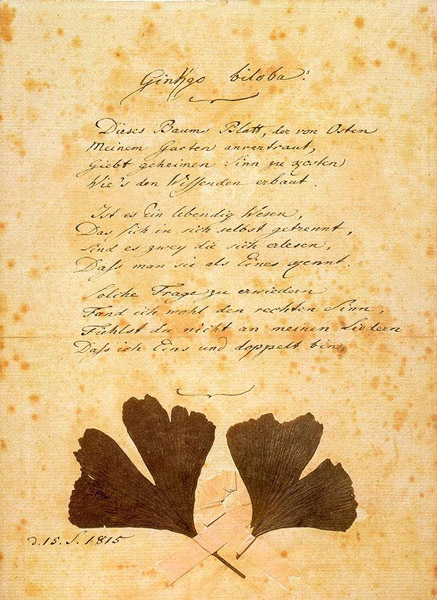
Shifting gears now toward the blessings of Ginkgo as a medicinal plant…..with an invitation to stay with the wonder of this tree as a being in its own right, not roaring off into the “what’s this plant for?” perspective that is so easy for us humans to veer to — almost despite our best intentions. OK, with that said……
For such an ancient tree to be associated with memory and graceful aging is not a big leap for us to make. Perhaps Ginkgo helps in this way because it holds the memories of an entire class of Plants, even an entire age, in its cellular makeup.
While in traditional Chinese medicine the seeds of the Ginkgo are most often used for the treatment of lung and respiratory ailments primarily, in the West, attention has focused on extracts from the leaves as a memory enhancer. The active compounds come from two main classes of chemicals — terpenoids and flavonoids. Flavonoids are said to have health benefits because they are a source of antioxidants in food. A few of the many medicinal benefits include: anticancer, antioxidant, anti-inflammatory, antiviral properties, neuroprotective, and cardio-protective effects.
Ginkgo leaves contain more than forty different flavonoids. The leaves are usually harvested just as they begin to turn color in the fall, as this is when the overall flavonoid content is highest. Some particular flavonoids, however, are more concentrated in the green spring and summer leaves.
In European medicine, Ginkgo leaf extract is prescribed for narrowing of the arteries around the heart and brain, a condition often seen in elderly folks dealing with difficulties in concentration and memory, absentmindedness, confusion, lack of energy and other symptoms. The active components improve vasodilation and circulation, and have been studied for more than 50 years.
In the US, Ginkgo leaf extract from the whole plant or standardized extracts is a popular herbal remedy for memory, though this plant is still relegated to the side of mainstream medicine, unlike its more integrated presence in the materia medica of Europe and China.
While most of the literature and studies concern Ginkgo in relation to memory enhancement, this plant has many other outstanding qualities that are sometimes overlooked:
* increasing the strength of the arterial walls, thus serving as a cardiac tonic.
* reducing inflammation in the blood vessels and helping prevent platelet aggregation and blood clotting that can lead to blocked arteries.
* generally promoting blood flow and oxygenation throughout the body.
* treating vertigo and tinnitus (ringing in the ears).(6)
Gingko works as a nutritive tonic, not a drug, so it must be used with consistency and in adequate amounts for several weeks or months before any benefit is noticed. Rosemary Gladstar, the beloved and trusted mother of modern herbalism in the US, recommends Ginkgo as a regular herbal tonic for everyone over the age of 45.
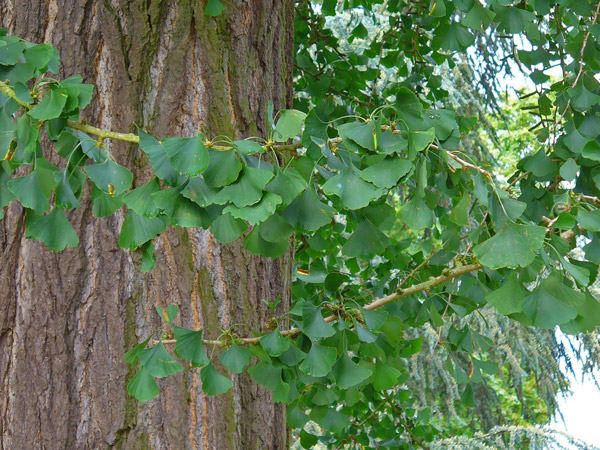
Here are some recipes for your consideration; Rosemary likes teas!
For improving memory: Ginkgo, Sage, Rosemary and Gotu Kola
For circulation: Ginkgo, Hawthorn, Lemon Balm
For stress and anxiety with mental worry: Ginkgo, Oats, Nettle (7)
You can gather the leaves yourself if you have a tree nearby or purchase the dried leaves; tinctures are readily available, or you can purchase standardized extract products on the market.
Ginkgo should not be taken with other blood-thinning medications or MAO inhibitors.
And a general disclaimer: The information presented here is for education only; I am not a physician and cannot diagnose, treat or prescribe for any health concern. I can provide education and make recommendations for your consideration.
You are welcome to contact me for an individualized herbal consult as part of my energy medicine practice.
I could go on and on with the fascinating medicinal, botanical, historical and artistic stories about Ginkgo. If you want more, botanist and former Director of the Royal Botanic Gardens in Kew UK Peter Crane has written a whole 384-page-book entitled Ginkgo. Check it out. Or your favorite search engine can direct you down many rabbit holes. And I have listed a few sources below.
Sometimes people ask me how I decide what Tree or Plant to write about. The way I know is this: the Plant lets me know. If I am paying attention, that is. Ginkgo showed up in my dreams a few weeks ago, to remind me of a magic deeper still as a tool of resilience and rootedness for our daily lives; as a reminder that Plants and Humans needs each other; as a reminder that no matter what, something true, beautiful and good will survive on this planet of contrasts. I am learning to remember. I am learning to listen. May it be so!
In Abundant Love,
Elizabeth
You are welcome to come see me for an energy balancing or herbalism session via phone or Zoom. Scheduling link here www.elizabethcombs.com or email/text me.
“It means,” said Aslan, “that though the Witch knew the Deep Magic, there is a magic deeper still which she did not know. Her knowledge goes back only to the dawn of time. But if she could have looked a little further back, into the stillness and the darkness before Time dawned, she would have read there a different incantation.“
CS Lewis, The Lion, the Witch and the Wardrobe
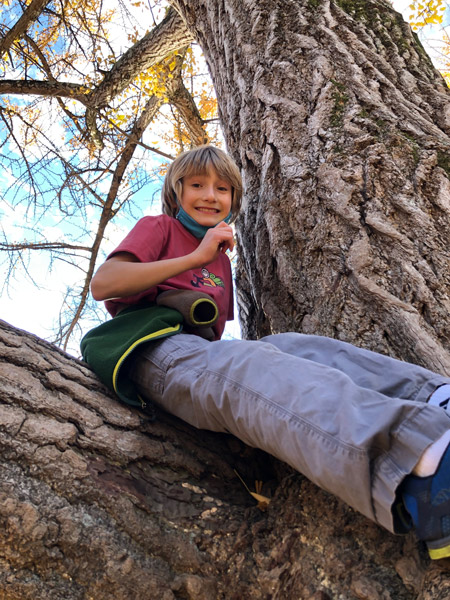
Sources:
1) Wang Chunwu, A Chronicle of Mt. Qingcheng, Sichuan Renmin Chubanshe 1994: 14.
2) Crane, Peter, Ginkgo, Yale University Press, New Haven & London, 2013, p 5.
3) Pang Z, Pan F, and He S, Ginkgo biloba: History, current status, and future prospects, Journal of Alternative and Complementary Medicine 1996; 2(3): 359-363.
4) Crane, p 5.
5) www.classicalchinesemedicine.org/ginkgo-cultural-background-medicinal-usage/
6) Gladstar, Rosemary, Herbal Recipes for Vibrant Health, Storey Publishing, N Adams MA, 2001, p 334-335.
7) Gladstar, p 335.
Other Sources
Tillotson, Allan Keith. The One Earth Herbal Sourcebook. Kensington Books, NY NY. 2001.
Hoffman, David. An Elders Herbal, Healing Arts Press, Rochester VT, 1993.
Photos are all in the public domain, Wikimedia Commons, or taken by me (EC); credits top to bottom:
1 Worcester Tree Initiative; 2 Wikimedia Commons: Marty Aligata (Cylburn Arboretum, Maryland); 3 Wikimedia Commons: Larry Gene Fleeman Foundation; 4 EC; 5 Wikimedia Commons: IsMoon; 6 Goethe-Museum Dusseldorf; 7 Wikimedia Commons H Zell 2009; 8 EC.
